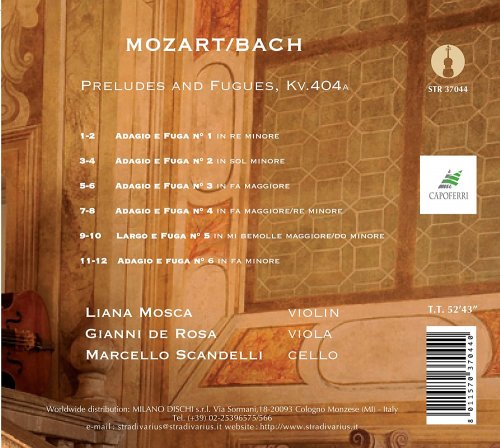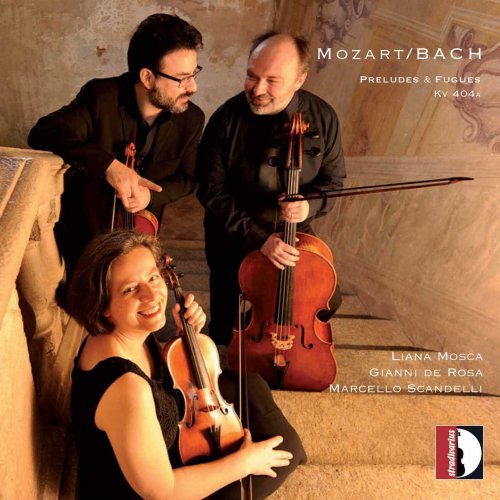
Il Furibondo - Mozart & Bach: Peludes & Fugues, K. 404a (2016)
BAND/ARTIST: Il Furibondo
- Title: Mozart & Bach: Peludes & Fugues, K. 404a
- Year Of Release: 2016
- Label: Stradivarius
- Genre: Classical
- Quality: flac lossless (tracks)
- Total Time: 00:52:42
- Total Size: 213 mb
- WebSite: Album Preview
Tracklist
01. 6 Preludes & Fugues, K. 404a: Prelude No. 1
02. 6 Preludes & Fugues, K. 404a: Fugue No. 1 (After J.S. Bach's BWV 853)
03. 6 Preludes & Fugues, K. 404a: Prelude No. 2
04. 6 Preludes & Fugues, K. 404a: Fugue No. 2 (After J.S. Bach's BWV 883)
05. 6 Preludes & Fugues, K. 404a: Prelude No. 3
06. 6 Preludes & Fugues, K. 404a: Fugue No. 3 (After J.S. Bach's BWV 882)
07. 6 Preludes & Fugues, K. 404a: Prelude No. 4 (After J.S. Bach's BWV 527)
08. 6 Preludes & Fugues, K. 404a: Fugue No. 4 (After J.S. Bach's BWV 1080 No. 8)
09. 6 Preludes & Fugues, K. 404a: Prelude No. 5 (After J.S. Bach's BWV 526)
10. 6 Preludes & Fugues, K. 404a: Fugue No. 5 (After J.S. Bach's BWV 526)
11. 6 Preludes & Fugues, K. 404a: Prelude No. 6
12. 6 Preludes & Fugues, K. 404a: Fugue No. 6 (After W.F. Bach's F. 31 No. 8)

The 6 Trios by J S. Bach, as originally described in the surviving manuscript bears the name of neither the arranger of Bachs pieces nor the composer of the slow introductions. Despite that, it has long been supposed that it was the work of W. A. Mozart. As far as we can trace, it was Wilhelm Rust, the editor of the volume 9 of the Bach-Gesellschaft edition, who in 1860 first made this connection. A more recent scholarship has identified many details that help us understand the complex backgrounds of these textual deviations found in the surviving manuscripts originated from Vienna in 1770-1800. Each Trio consists of a slow introduction and a fugue. While it retains Bachs original prelude-fugue design, the keyboard prelude was replaced with something more suitable for string ensemble. In a sense, the arrangement has a close affiliation with the Baroque Sonata da chiesa (i.e. the first two movements of the four-movement set ""slow-fast-slow-fast""), the genre, which represents the repertoire of the past, appears to have been much appreciated among the connoisseurs of music in the late eighteenth-century Vienna. The slow introduction typically begins in the tonic and closes in the dominant, so that the main piece, the fugue, can begin in a well-prepared mood. Similarly it makes use of the melodic material that hints the ensuing announcement of the fugue subject. Thus the introduction unfolds in such a manner so that when the fugue subject appears ceremoniously, one feels that at last a show has begun.
01. 6 Preludes & Fugues, K. 404a: Prelude No. 1
02. 6 Preludes & Fugues, K. 404a: Fugue No. 1 (After J.S. Bach's BWV 853)
03. 6 Preludes & Fugues, K. 404a: Prelude No. 2
04. 6 Preludes & Fugues, K. 404a: Fugue No. 2 (After J.S. Bach's BWV 883)
05. 6 Preludes & Fugues, K. 404a: Prelude No. 3
06. 6 Preludes & Fugues, K. 404a: Fugue No. 3 (After J.S. Bach's BWV 882)
07. 6 Preludes & Fugues, K. 404a: Prelude No. 4 (After J.S. Bach's BWV 527)
08. 6 Preludes & Fugues, K. 404a: Fugue No. 4 (After J.S. Bach's BWV 1080 No. 8)
09. 6 Preludes & Fugues, K. 404a: Prelude No. 5 (After J.S. Bach's BWV 526)
10. 6 Preludes & Fugues, K. 404a: Fugue No. 5 (After J.S. Bach's BWV 526)
11. 6 Preludes & Fugues, K. 404a: Prelude No. 6
12. 6 Preludes & Fugues, K. 404a: Fugue No. 6 (After W.F. Bach's F. 31 No. 8)

The 6 Trios by J S. Bach, as originally described in the surviving manuscript bears the name of neither the arranger of Bachs pieces nor the composer of the slow introductions. Despite that, it has long been supposed that it was the work of W. A. Mozart. As far as we can trace, it was Wilhelm Rust, the editor of the volume 9 of the Bach-Gesellschaft edition, who in 1860 first made this connection. A more recent scholarship has identified many details that help us understand the complex backgrounds of these textual deviations found in the surviving manuscripts originated from Vienna in 1770-1800. Each Trio consists of a slow introduction and a fugue. While it retains Bachs original prelude-fugue design, the keyboard prelude was replaced with something more suitable for string ensemble. In a sense, the arrangement has a close affiliation with the Baroque Sonata da chiesa (i.e. the first two movements of the four-movement set ""slow-fast-slow-fast""), the genre, which represents the repertoire of the past, appears to have been much appreciated among the connoisseurs of music in the late eighteenth-century Vienna. The slow introduction typically begins in the tonic and closes in the dominant, so that the main piece, the fugue, can begin in a well-prepared mood. Similarly it makes use of the melodic material that hints the ensuing announcement of the fugue subject. Thus the introduction unfolds in such a manner so that when the fugue subject appears ceremoniously, one feels that at last a show has begun.
Year 2016 | Classical | FLAC / APE
As a ISRA.CLOUD's PREMIUM member you will have the following benefits:
- Unlimited high speed downloads
- Download directly without waiting time
- Unlimited parallel downloads
- Support for download accelerators
- No advertising
- Resume broken downloads


